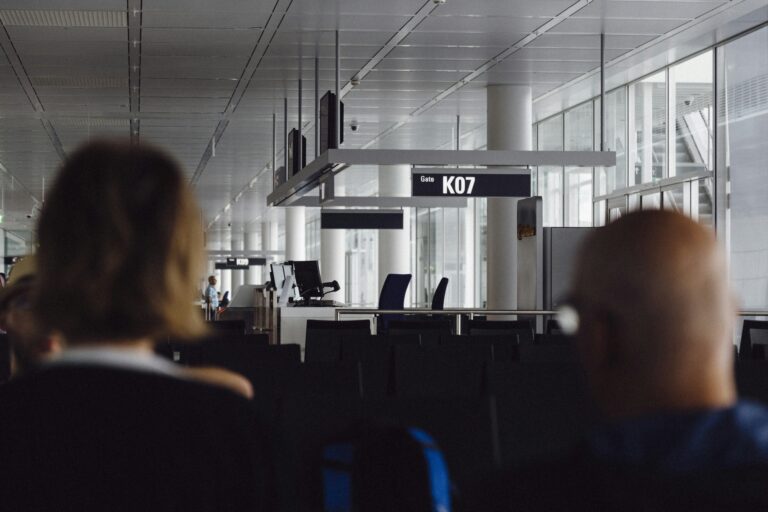AI: The New Co-Pilot in Airline Operations
Insights from Practical Applications and Future Directions
The airline industry is undergoing a significant transformation. For decades, this complex and highly coordinated system relied on human expertise and manual processes. Today, however, it’s entering a new chapter one shaped by smart technologies that improve efficiency, reduce costs, and enhance the overall travel experience.
From flight scheduling and revenue management to ground handling and maintenance planning, digital tools are becoming part of every step in airline operations. They not only simplify tasks but also make it possible to anticipate problems before they occur, respond to disruptions more quickly, and better understand what passengers need and expect.
Just imagine: flight schedules that adapt in real time to changes in weather or traffic, technical issues spotted before they cause delays, or emergency-driven ticket demand handled more fairly and flexibly. These are no longer futuristic ideas they’re now part of daily operations. This shift shows that digital systems have moved beyond being helpful add-ons; they’ve become strategic partners in how airlines run.

From Baggage Belts to Business Models: A Quick Look Back
Innovative tools have been used in aviation for years, but their role has grown rapidly in recent times. Initially, their job was simple to predict baggage flow or optimize crew schedules. But over time, they’ve taken on more complex responsibilities, such as setting ticket prices, redesigning route networks, or identifying maintenance needs before a problem even surfaces.
Today, large airlines such as Delta and Lufthansa are utilizing data-driven systems to detect component wear and tear early, enabling them to reduce delays and lower costs. Others use these tools to personalize passenger offers or adjust prices dynamically depending on demand.
Yet, despite this progress, most research and reporting in the field still focus on isolated functions, such as pricing or maintenance, rather than examining how these tools are reshaping the entire operation. There is also limited discussion on critical issues, such as how decisions are made, whether the process is fair, or what happens to passenger data along the way.
That’s where this article comes in. The goal here is to go beyond the buzzwords to explore how innovative technologies are used in daily airline operations, what they do well, and where they still fall short. Through real-world examples and lessons learned, we’ll take a closer look at the promises, pitfalls, and future directions of this ongoing shift.
Case Studies and Insights from Practice
Understanding how technology performs in controlled simulations is one thing but seeing how it responds to real challenges is where things get interesting. In this section, we take a look at how smart systems are being used across the airline industry, highlighting five examples that reveal both their power and their current limitations.
1. The Istanbul Earthquake and a Pricing Dilemma
A 6.2 magnitude earthquake hit Istanbul in April 2025 which forced schools to shut down and caused a rapid rise in travel bookings. The rapid surge in demand exceeded the capacity of conventional fare systems because dynamic pricing algorithms increased ticket prices to more than four times their usual value. Although the model functioned as designed, it exposed a critical gap: dynamic pricing algorithms currently lack the contextual awareness to differentiate between regular market-driven demand and crisis-induced demand.
This incident highlighted the potential for AI-enhanced models to incorporate real-time external event detection (e.g., natural disasters) and apply temporary pricing constraints. Airlines could leverage natural language processing and social media trend analysis to identify crisis events and override standard fare escalation mechanisms.
2. Rethinking Flight Plans Every Week, Not Just Every Season
Traditional airline scheduling is typically structured around biannual seasonal schedules. However, AI-powered demand prediction models now allow for weekly re-optimization of network plans. By analyzing real-time booking trends, competitor activity, weather forecasts, and macroeconomic indicators, airlines can dynamically adjust frequencies and aircraft types to match anticipated demand.
In practice, this model has been tested for high-traffic corridors where even a 5% shift in capacity can lead to substantial revenue improvements and operational efficiency. Weekly network planning, once unthinkable due to manual planning limitations, is now becoming technically feasible with AI assistance.
3. Catching Problems Before They Happen
Airlines such as Delta have piloted AI-driven predictive maintenance systems that analyze aircraft historical performance data, component life cycles, and external conditions to forecast potential failures before they occur. This approach has reduced unscheduled maintenance events and improved on-time performance.
Applying similar models across global airline fleets offers the potential for cost savings and significant improvements in reliability and customer satisfaction. Predictive maintenance also contributes to environmental sustainability by reducing unnecessary part replacements and maintenance flights.
4. Smoother Operations on the Ground
Slot coordination at congested airports remains a critical challenge. Expert discussions within this study (e.g., industry professionals with experience in slot management) revealed opportunities for AI-supported tools to optimize slot allocation, gate assignments, and ground crew deployment.
Advanced simulation models can help airlines and airport authorities reduce taxi times, improve ground handling efficiency, and avoid unnecessary slot underutilization. AI-driven predictive models can also assist in recommending alternative slot allocations based on historical patterns and anticipated disruptions.
5. Spotting Travel Trends Before They Hit the Booking System
Airlines are beginning to use AI to monitor web search volumes, social media trends, and booking data in real time. For instance, a 60% increase in search volume for flights from Istanbul to Riyadh can prompt airlines to plan their capacity and run promotional campaigns proactively.
The airline uses its micro-demand signal detection capabilities to capture revenue opportunities before competitors while reducing the risks of over- or under-capacity on high-traffic routes.
Each of these examples demonstrates a distinct way in which technology is enabling airlines to become more agile, efficient, and better connected to real-world signals. However, they also indicate that these systems are most effective when combined with thoughtful planning and apparent human oversight.
Should Smart Systems Always Decide? A Look at Ethics in Airline Tech
While more innovative systems can help airlines make faster and more accurate decisions, there’s a growing awareness that speed and efficiency aren’t everything. When automated decisions directly affect passengers what they pay, where they sit, whether their flight is delayed ethical questions come to the surface.
Fairness and Transparency: Who Sets the Price and Why?
One of the biggest concerns is pricing. When two passengers pay very different amounts for the same seat, they might not understand why. In many cases, the pricing system is based on algorithms that evaluate supply, demand, booking timing, and even browsing behavior.
But these systems aren’t always easy to explain. And when they rely on historical data, there’s a risk of repeating past biases intentionally or not. That’s why transparency matters. Airlines are being called on to ensure that their systems not only work but that they can be understood, justified, and trusted.
Keeping Humans in the Loop
As more responsibilities shift to technology, many experts argue that human oversight is more important than ever. The best systems support decision-making they don’t replace it. For example, a digital tool might flag a potential mechanical issue, but an engineer still decides whether to ground the plane. A pricing tool may suggest a fare change, but revenue managers ultimately make the final decision. This balance helps maintain accountability and builds confidence among staff and customers alike. Especially in safety-critical environments like aviation, the human factor isn’t just a backup it’s essential.
Regulations Are Still Catching Up
Here’s the challenge: while technology moves fast, regulations often don’t. In many countries, there are still no clear standards for the use of innovative decision-making tools in flight operations or passenger services. As a result, airlines must take the lead in developing responsible guidelines. That means thinking ahead not just about what’s possible, but about what’s right.
A Co-Pilot, Not a Commander: The Future of Airline Tech
Innovative technologies are no longer just nice-to-have features in aviation they’re becoming essential tools for keeping operations efficient, responsive, and resilient. From helping airlines respond to sudden shifts in demand, to detecting maintenance issues early, to offering passengers more tailored experiences, the benefits are real and growing.
But perhaps the biggest lesson is this: technology works best when it empowers people, not replaces them.
Whether it’s a maintenance alert or a ticket pricing suggestion, the most effective systems are those that support human expertise rather than sideline it. In such a high-stakes industry, trust, responsibility, and transparency are just as important as speed and accuracy.
What’s Next?
The next phase of innovation in aviation won’t just be about adding more software or sensors. It will require:
- Systems that explain themselves – so decisions can be reviewed and trusted.
- Faster, more innovative responses to disruptions – from weather events to global crises.
- Better collaboration between humans and machines – not just in technical roles, but across entire organizations.
- Clearer ethical and legal guidelines – to ensure passengers’ rights and safety come first.
In short, innovative technologies aren’t just tools for operational efficiency they can become strategic partners in the future of aviation. If integrated thoughtfully, these systems won’t just improve how airlines run; they’ll help drive transformation in everything from flight safety to passenger satisfaction.
References
Abdelghany, K. F., Abdelghany, A. F., & Ekollu, G. (2007). An integrated decision support tool for airlines schedule recovery during irregular operations. European Journal of Operational Research, 185(2), 825–848. https://doi.org/10.1016/j.ejor.2006.02.039.
Floridi, L., Cowls, J., Beltrametti, M., Chatila, R., Chazerand, P., Dignum, V., … & Vayena, E. (2018). AI4People An ethical framework for a good AI society: Opportunities, risks, principles, and recommendations. Minds and Machines, 28(4), 689–707. https://doi.org/10.1007/s11023-018-9482-5.
Gavranović, H., & Čupić, M. (2017). A new approach to crew pairing optimization using artificial intelligence. Transportation Research Procedia, 28, 213–220. https://doi.org/10.1016/j.trpro.2017.12.189.
Huse, M., & Silkoset, R. (2023). Pricing: A guide to pricing decisions. Springer. https://doi.org/10.1007/978-3-031-25827-1.
Jiang, B., Zhang, J., Fu, J., Ding, G., & Zhang, Y. (2024). Research on check-in baggage flow prediction for airport departure passengers based on improved PSO-BP neural network combination model. Aerospace, 11(11), 953. https://doi.org/10.3390/aerospace11110953.
Lu, X., Zhang, Y., & Yu, M. (2022). A hybrid AI-based recommendation system for personalized ancillary services in the airline industry. Journal of Air Transport Management, 100, 102122. https://doi.org/10.1016/j.jairtraman.2022.102122.
Saxena, A., & Saad, S. M. (2020). Predictive analytics in aviation maintenance: Data mining techniques for reliability centered maintenance. Journal of Quality in Maintenance Engineering, 26(4), 511–529. https://doi.org/10.1108/JQME-03-2020-0014.
Pictures: Freepik, Pixabay







